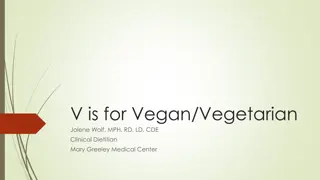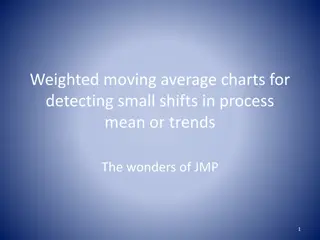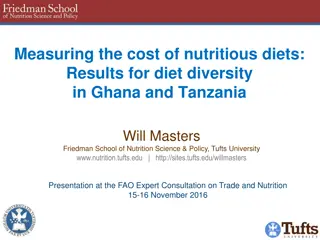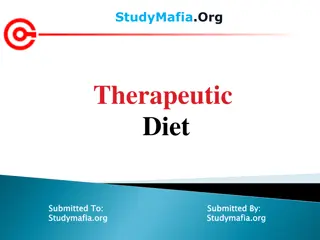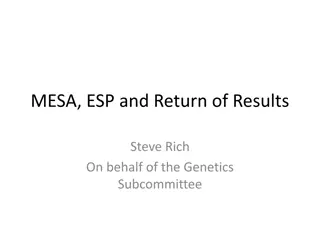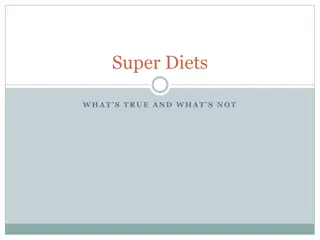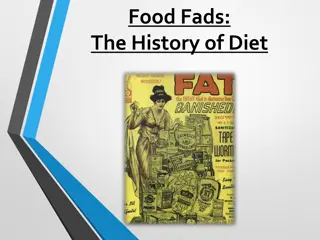Understanding Cost Variants in Healthy Diets: Least Cost vs Preference Weighted
The discussion delves into the concept of least-cost versus preference-weighted healthy diets, highlighting the differences in cost and food selection. It explores how preference weighting takes into account food preferences of low-income consumers, providing insights into the affordability and cultural suitability of healthy diets. The comparison between least-cost and preference-weighted approaches offers valuable perspectives on optimizing food choices within dietary guidelines.
Download Presentation

Please find below an Image/Link to download the presentation.
The content on the website is provided AS IS for your information and personal use only. It may not be sold, licensed, or shared on other websites without obtaining consent from the author. Download presentation by click this link. If you encounter any issues during the download, it is possible that the publisher has removed the file from their server.
E N D
Presentation Transcript
1 Technical Session 7 Variant of the Cost of Healthy Diet: Least cost vs. Preference weighted Dr. Anna Herforth with Kristi Mahrt, Sherman Robinson, Channing Arndt, Derek Headey, IFPRI 17 February 2022
2 Least-cost healthy diet Minimum cost needed to meet dietary guidelines. It always provides a balanced diet, but might not be the most preferred foods. Food group Least-cost items in Pakistan in June 2017 Starchy staples Wheat, rice Protein-rich foods Masoor dal, black gram Dairy Curd, fresh unboiled milk Fruits Turbooz, kharbooza Vegetables Onion, eggplant, spinach Oils Cooking oil Source: Dizon and Herforth 2018
3 Preference-weighted cost of a healthy diet The Preference-Weighted Cost of a Healthy Diet (PW) uses all foods for which there are food price observations weighted by their expenditure shares, instead of only least-cost items. Reflects food preferences among the lowest-income consumers, while holding fixed the proportions of food groups to meet dietary guidelines. Can be useful to understand the cost of a more culturally preferable diet and how much of a premium it has compared to least-cost.
4 Preference weights are expenditure weights Hold food group proportions fixed Within food group: o LC: selects only 1-3 least-cost items weighted equally o PW: select all items, weighted by expenditure share LC = Least Cost PW = Preference-Weighted
5 Preference weights are expenditure weights Food group FIXED FOR BOTH LC and PW Total energy number of food items selected for LC number of food items selected for PW As many as are in the price dataset (~12) As many as are in the price dataset (~8) As many as are in the price dataset (~6) As many as are in the price dataset (~20) Hold food group proportions fixed content (kcal) Starchy staples 1172 2 Within food group, instead of selecting only 1-3 least-cost items, select all items, weighted by expenditure share Animal-source foods 287 Vegetables 130 3 Fruits 158 2 2 Legumes, nuts & seeds As many as are in the price dataset (~5) As many as are in the price dataset (~3) 290 1 Oils and fats 292 1
Demonstration: how a least-cost healthy diet differs from one incorporating preference weights Source: Herforth, A., Bai, Y., Venkat, A., Mahrt, K., Ebel, A. & Masters, W.A. 2020. Cost and affordability of healthy diets across and within countries. Background paper for The State of Food Security and Nutrition in the World 2020. FAO Agricultural Development Economics Technical Study No. 9. Rome, FAO. https://doi.org/10.4060/cb2431en
Food prices create a ladder of affordability When all diets are affordable, food prices are one of many influences on food choice. When healthy diets are unaffordable, food prices are an insurmountable barrier to improved diet quality. Preference- weighted: Appropriate for poverty lines Other goals (convenience, preferences) Least-cost: Minimum for food security Healthy diets (meet food group recommendations) Nutrient adequacy (avoid deficiencies or excesses of essential nutrients) Caloric adequacy (short-term subsistence) Source: Food Prices for Nutrition, August 2021 Mistaken for food security
8 Why are we talking about this metric with regard to poverty? Observation: In all countries, the cost of a healthy diet is higher than the poverty line.
Healthy diets by any definition are far more expensive than the entire international poverty line >$3.50 Median cost of 10 guidelines $1.90 (total poverty line) $1.20 (food poverty line) Source: Herforth et al., 2020, SOFI 2020
10 Why are we talking about this metric with regard to poverty? Observation: In all countries, the cost of a healthy diet is higher than the poverty line. Logic problem. o If people cannot afford a healthy diet aren t they poor? o There are many more poor people than poverty lines suggest. o That is, current poverty lines underestimate true poverty. Observation: In most countries, malnutrition rates are higher than poverty rates. o The discrepancy is resolved when the food poverty line is based on the cost of a healthy diet.
Need to reconsider Need to reconsider poverty lines poverty lines Food poverty line is based on kcal equivalent of common diet among the poor Need to allow for the cost of a nutritious/healthy diet
12 Construction of food poverty lines: Current practice vs. a standard that meets dietary needs Cost of Basic Needs approach is typically used for setting food poverty lines In theory, can be based on whatever is considered a basic need. In practice, only two criteria: (1) calorie adequacy and (2) typical expenditure shares of the poor. Cost of a Healthy Diet PW o retains these two criteria for traditional food poverty lines o adds the criteria of meeting FBDGs. Retains the same items the poor usually consume, but in the quantities and proportions that fulfill food group requirements.
Poverty lines could be based on healthy diet costs Dietary guidelines could be used to construct poverty lines and safety nets around the cost of a healthy diet -- For example, Myanmar now uses a basic needs poverty line based on actual expenditure shares -- Using least-cost items in each food group to form a healthy diet alters weights, and coincidentally in this case does not alter the overall level -- Using expenditure shares (among the poorest) within food groups would raise diet costs and the level of the poverty line (Least-cost) Source: Herforth, A., Bai, Y., Venkat, A., Mahrt, K., Ebel, A. & Masters, W.A. 2020. Cost and affordability of healthy diets across and within countries. Background paper for The State of Food Security and Nutrition in the World 2020. FAO Agricultural Development Economics Technical Study No. 9. Rome, FAO. https://doi.org/10.4060/cb2431en
Existing food poverty line standard, based on consumption patterns of the poor, is very nutritionally deficient. 14
United States revision to food assistance program benefits (Aug 15, 2021) Updated to meet new U.S. food-based dietary guidelines For at least a decade, critics of the benefits have said they were too low to provide an adequate diet. The previous basket drew on spending data limited to the poor that created a circular logic estimating the cost of an adequate diet with data from people who cannot afford one Approx. $6.90 per day (nominal USD, 2021) Source: The New York Times, 08.15.2021
16 Summary To calculate the preference-weighted Cost of a Healthy Diet, the full food list is used, and expenditure weights are needed to weight food items within food groups in fixed proportions. The range between the least-cost and preference-weighted variants may be a realistic range of what poor people would spend to meet dietary guidelines. Also the preference premium may be of interest.
17 Summary To calculate the preference-weighted Cost of a Healthy Diet, the full food list is used, and expenditure weights are needed to weight food items within food groups in fixed proportions. The range between the least-cost and preference-weighted variants may be a realistic range of what poor people would spend to meet dietary guidelines. For poverty lines, a revolution in thinking is needed: Nutrition as a Basic Need. o Keep using the CBN approach (Cost of Basic Needs) o But consider a healthy diet to be a basic need. Recall: sufficient nutritious food to meet dietary needs and food preferences for an active and healthy life
18 Discussion







